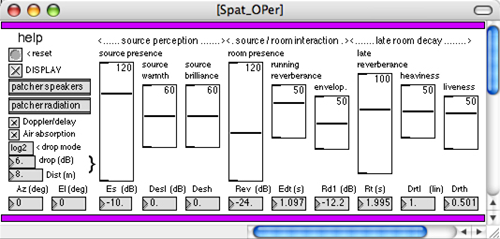Spatialisateur
Spat Introduction
|
Perceptual ControlIntroductionThis part covers the definition of acoustic quality and the related perceptual factors. Definition of Acoustic QualityThe term `acoustic quality' is used in Spat_OPer to describe globally the transformations undergone by the message radiated by a sound source before it reaches the listener. In a natural situation with a sound source and a listener in a room, the acoustic quality is influenced by:
Two remarks should be made regarding the definition of the acoustic quality used here:
Although this approach is possible [2, 8], it has a number of disadvantages in the context of real-time musical applications:
The approach adopted in the Spatialisateur project allows to design a spatial processor which does not rely on a physical and geometrical description of the virtual environment for synthesizing the room effect. Instead, the proposed user-interface is directly related to the perception of the reproduced sound by the listener. In a musical context, this approach allows to immediately take the acoustic quality into account at the composition stage (by integrating perceptual attributes in the score, for example), without referring to a particular electroacoustic setup or to the place where the work will actually be performed. Additionally, the real-time computational efficiency is maximized since processing is focussed on the reproduction and control of perceptually relevant attributes. The Perceptual FactorsIn the proposed control interface, the acoustic quality is described in terms of mutually independent perceptual factors. These perceptual factors were derived from psychoacoustic research on the characterization of the acoustic quality of concert halls [6, 10]. As a result of these studies, each perceptual factor is related to a measurable objective criterion. This allows for the translation of the perceptual factors into DSP parameters, and allows to reproduce the acoustic quality of an existing room. The perceptual factors form the most relevant basis for controlling interpolation processes between different acoustic qualities. The perceptual factors are manipulated by means of sliders which are scaled to account for the average sensitivity of listeners with respect to the different factors. They were given names by the research team and can be categorized as follows (the perceptual factors are listed in the left column, the objective criteria are indicated in the right column). A group of 6 perceptual factors describing effects which depend of the position, directivity and orientation of the source. The first 3 are perceived as characteristics of the source. The next 3 are perceptually associated to the room: • source presence: early sound (energy of direct sound and early room effect) • source brilliance: variation of early sound at high frequencies • source warmth: variation of early sound at low frequencies • room presence: late sound: energy of later reflections and reverberation • running reverberance: early decay time • envelopment: energy of early room effect relative to direct sound A group of 3 perceptual factors describing effects which are characteristics of the room: • late reverberance: mid-frequency decay time • liveness: relative decay time at high frequencies • intimacy: relative decay time at low frequencies  The Spat_Oper The Spat_Oper is a perceptual user-interface for controlling the acoustic quality. A variation of the source presence creates a convincing effect of proximity or remoteness of the sound source. The term "reverberance" refers to the sensation that sounds are prolonged by the room reverberation. Late reverberance differs from running reverberance by the fact that it is essentially perceived during interruptions of the message radiated by the source. Running reverberance, on the contrary, remains perceived during continuous music. Nota Bene: This perceptual control interface only affects the DSP parameters of the Room~ module. When Spat_OPer is used, the high and low transition frequencies are given fixed values everywhere within Room~, for all spectral corrections and for the decay time as well (see sections ). Also, note that independant control of the above perceptual factors is only available if a "full" version of the Room~ DSP module is used (allowing separate control of the direct, early, cluster andreverb energies - see section ). For instance, with a "reduced" version of Room~ where the 'cluster' section is not accessible, the running reverberance cannot be controlled independently from the other perceptual factors. |
© CNAC-GP/Ircam and Espaces Nouveaux |